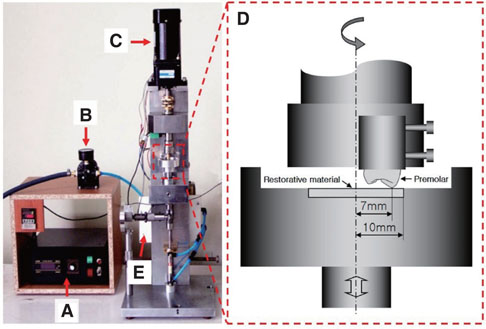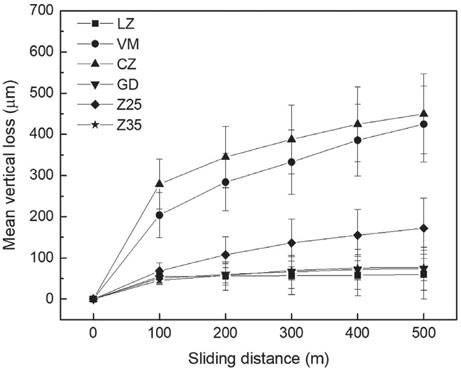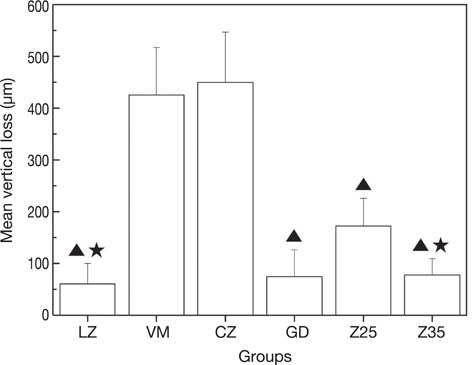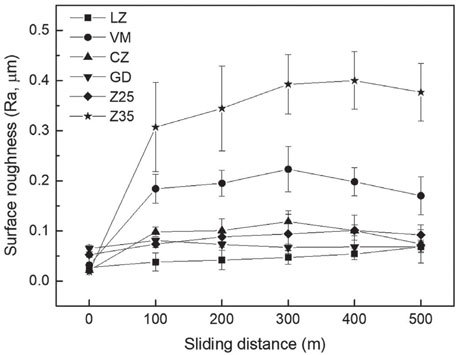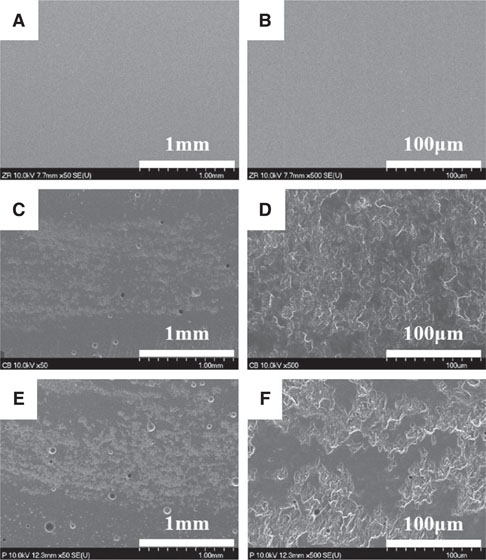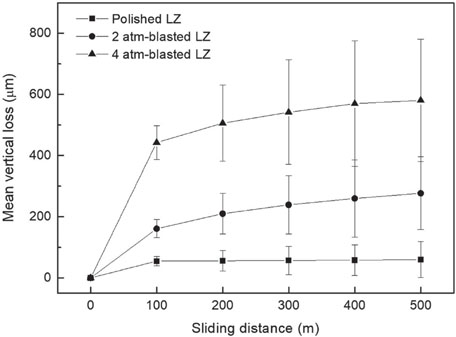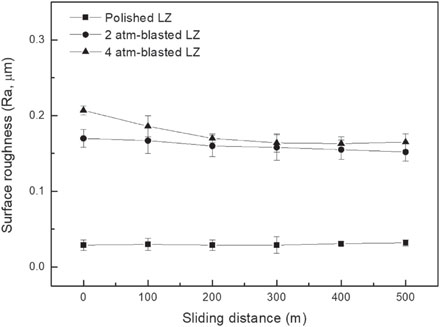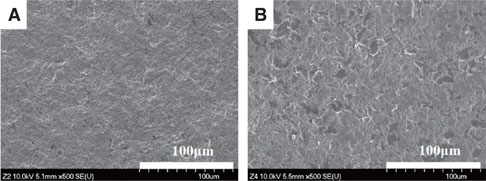J Adv Prosthodont.
2019 Feb;11(1):7-15. 10.4047/jap.2019.11.1.7.
In vitro wear behavior between enamel cusp and three aesthetic restorative materials: Zirconia, porcelain, and composite resin
- Affiliations
-
- 1Department of Dental Biomaterials, Institute of Oral Bioscience and Institute of Biodegradable Material, BK21 Plus Project, School of Dentistry, Chonbuk National University, Jeonju, Republic of Korea. bts@jbnu.ac.kr
- 2Odonto-stomatology Faculty, Hue University of Medicine and Pharmacy, Hue University, Hue City, Vietnam.
- 3Department of Pediatric Dentistry and Institute of Biodegradable Material, School of Dentistry, Chonbuk National University, Jeonju, Republic of Korea.
- 4Plant Dental Clinic, Daejeon, Republic of Korea.
- KMID: 2438926
- DOI: http://doi.org/10.4047/jap.2019.11.1.7
Abstract
- PURPOSE
The aim of this study was to identify the effects of three aesthetic restorative materials on the wear between tooth and restoration by a pin-on-disk manner.
MATERIALS AND METHODS
Six aesthetic restorative materials were used to prepare disk specimens for wear test, which were Lava Zirconia as zirconia group, Vintage MP and Cerabien ZR as veneering porcelain group, Gradia Direct microhybrid composite containing prepolymerized fillers, Filtek Z250 microhybrid composite containing zirconia glass and colloidal silica particles, and Filtek Z350 nanocomposite as composite resin group. Vertical loss of the worn cusp, change of the surface roughness of the restoration materials, and the surface topography were investigated after wear test under 9.8-N contact load.
RESULTS
The porcelain groups (Vintage MP and Cerabien ZR) caused the largest vertical loss of teeth when compared with those of the composite resin and zirconia groups, and Filtek Z250 microhybrid composite results in the second-largest vertical loss of teeth. The surface of Filtek Z350 nanocomposite was deeply worn out, but visible wear on the surface of the zirconia and Gradia Direct microhybrid composite was not observed. When the zirconia surface was roughened by sand-blasting, vertical loss of teeth considerably increased when compared with that in the case of fine polished zirconia.
CONCLUSION
It was identified that microhybrid composite resin containing a prepolymerized filler and zirconia with reduced surface roughness by polishing were the most desirable restorative materials among the tested materials to prevent the two-body wear between aesthetic restorative material and tooth.
MeSH Terms
Figure
Reference
-
1. Lambrechts P, Debels E, Van Landuyt K, Peumans M, Van Meerbeek B. How to simulate wear? Overview of existing methods. Dent Mater. 2006; 22:693–701.2. Mukatash Nimri EG. Wear mechanisms and wear investigations of dental materials; a review of the literature. Arch Oral Dent Res. 2015; 2:3.
Article3. Smith BG, Bartlett DW, Robb ND. The prevalence, etiology and management of tooth wear in the United Kingdom. J Prosthet Dent. 1997; 78:367–372.
Article4. Elmaria A, Goldstein G, Vijayaraghavan T, Legeros RZ, Hittelman EL. An evaluation of wear when enamel is opposed by various ceramic materials and gold. J Prosthet Dent. 2006; 96:345–353.
Article5. Lambrechts P, Braem M, Vuylsteke-Wauters M, Vanherle G. Quantitative in vivo wear of human enamel. J Dent Res. 1989; 68:1752–1754.
Article6. Lee A, He LH, Lyons K, Swain MV. Tooth wear and wear investigations in dentistry. J Oral Rehabil. 2012; 39:217–225.
Article7. Guazzato M, Albakry M, Ringer SP, Swain MV. Strength, fracture toughness and microstructure of a selection of all-ceramic materials. Part II. Zirconia-based dental ceramics. Dent Mater. 2004; 20:449–456.
Article8. Albashaireh ZS, Ghazal M, Kern M. Two-body wear of different ceramic materials opposed to zirconia ceramic. J Prosthet Dent. 2010; 104:105–113.
Article9. Kim MJ, Oh SH, Kim JH, Ju SW, Seo DG, Jun SH, Ahn JS, Ryu JJ. Wear evaluation of the human enamel opposing different Y-TZP dental ceramics and other porcelains. J Dent. 2012; 40:979–988.
Article10. Preis V, Hahnel S, Kolbeck C, Behrend D, Warkentin M, Handel G, Rosentritt M. Wear performance of dental materials: A comparison of substructure ceramics, veneering ceramics, and non-precious alloys. Adv Eng Mater. 2011; 13:B432–B439.
Article11. Kimmich M, Stappert CF. Intraoral treatment of veneering porcelain chipping of fixed dental restorations: a review and clinical application. J Am Dent Assoc. 2013; 144:31–44.12. Preis V, Behr M, Kolbeck C, Hahnel S, Handel G, Rosentritt M. Wear performance of substructure ceramics and veneering porcelains. Dent Mater. 2011; 27:796–804.
Article13. Jandt KD, Sigusch BW. Future perspectives of resin-based dental materials. Dent Mater. 2009; 25:1001–1006.
Article14. Christensen GJ. Remaining challenges with Class II resin-based composite restorations. J Am Dent Assoc. 2007; 138:1487–1489.
Article15. Hahnel S, Schultz S, Trempler C, Ach B, Handel G, Rosentritt M. Two-body wear of dental restorative materials. J Mech Behav Biomed Mater. 2011; 4:237–244.
Article16. Mitra SB, Wu D, Holmes BN. An application of nanotechnology in advanced dental materials. J Am Dent Assoc. 2003; 134:1382–1390.
Article17. Heintze SD, Cavalleri A, Forjanic M, Zellweger G, Rousson V. Wear of ceramic and antagonist-a systematic evaluation of influencing factors in vitro. Dent Mater. 2008; 24:433–449.
Article18. Hmaidouch R, Weigl P. Tooth wear against ceramic crowns in posterior region: a systematic literature review. Int J Oral Sci. 2013; 5:183–190.
Article19. Osiewicz MA, Werner A, Pytko-Polonczyk J, Roeters FJ, Kleverlaan CJ. Contact- and contact-free wear between various resin composites. Dent Mater. 2015; 31:134–140.
Article20. Koottathape N, Takahashi H, Iwasaki N, Kanehira M, Finger WJ. Quantitative wear and wear damage analysis of composite resins in vitro. J Mech Behav Biomed Mater. 2014; 29:508–516.
Article21. Cao L, Zhao X, Gong X, Zhao S. An in vitro investigation of wear resistance and hardness of composite resins. Int J Clin Exp Med. 2013; 6:423–430.22. Sripetchdanond J, Leevailoj C. Wear of human enamel opposing monolithic zirconia, glass ceramic, and composite resin: an in vitro study. J Prosthet Dent. 2014; 112:1141–1150.23. DeLong R. Intra-oral restorative materials wear: rethinking the current approaches: how to measure wear. Dent Mater. 2006; 22:702–711.
Article24. Condon JR, Ferracane JL. Evaluation of composite wear with a new multi-mode oral wear simulator. Dent Mater. 1996; 12:218–226.
Article25. Kadokawa A, Suzuki S, Tanaka T. Wear evaluation of porcelain opposing gold, composite resin, and enamel. J Prosthet Dent. 2006; 96:258–265.
Article26. Harrison A. Wear of combinations of acrylic resin and porcelain, on an abrasion testing machine. J Oral Rehabil. 1978; 5:111–115.
Article27. Zheng J, Zhou ZR, Zhang J, Li H, Yu HY. On the friction and wear behaviour of human tooth enamel and dentin. Wear. 2003; 255:967–974.
Article28. Ekfeldt A, Oilo G. Occlusal contact wear of prosthodontic materials. An in vivo study. Acta Odontol Scand. 1988; 46:159–169.
Article29. Mahalick JA, Knap FJ, Weiter EJ. Occlusal wear in prosthodontics. J Am Dent Assoc. 1971; 82:154–159.
Article30. Blackham JT, Vandewalle KS, Lien W. Properties of hybrid resin composite systems containing prepolymerized filler particles. Oper Dent. 2009; 34:697–702.
Article31. Yesil ZD, Alapati S, Johnston W, Seghi RR. Evaluation of the wear resistance of new nanocomposite resin restorative materials. J Prosthet Dent. 2008; 99:435–443.
Article32. Palaniappan S, Bharadwaj D, Mattar DL, Peumans M, Van Meerbeek B, Lambrechts P. Nanofilled and microhybrid composite restorations: Five-year clinical wear performances. Dent Mater. 2011; 27:692–700.
Article33. Ghazal M, Kern M. The influence of antagonistic surface roughness on the wear of human enamel and nanofilled composite resin artificial teeth. J Prosthet Dent. 2009; 101:342–349.
Article34. Lutz F, Phillips RW, Roulet JF, Setcos JC. In vivo and in vitro wear of potential posterior composites. J Dent Res. 1984; 63:914–920.
Article35. Mair LH, Stolarski TA, Vowles RW, Lloyd CH. Wear: mechanisms, manifestations and measurement. Report of a workshop. J Dent. 1996; 24:141–148.
Article36. Braem M, Lambrechts P, Van Doren V, Vanherle G. In vivo evaluation of four posterior composites: quantitative wear measurements and clinical behavior. Dent Mater. 1986; 2:106–113.
Article37. Preis V, Schmalzbauer M, Bougeard D, Schneider-Feyrer S, Rosentritt M. Surface properties of monolithic zirconia after dental adjustment treatments and in vitro wear simulation. J Dent. 2015; 43:133–139.
Article38. Seghi RR, Rosenstiel SF, Bauer P. Abrasion of human enamel by different dental ceramics in vitro. J Dent Res. 1991; 70:221–225.
Article
- Full Text Links
- Actions
-
Cited
- CITED
-
- Close
- Share
- Similar articles
-
- COMPARISON OF WEAR RESISTANCE AMONG RESIN DENTURE TEETH OPPOSING VARIOUS RESTORATIVE MATERIALS
- An In-Vitro Wear Study of Ceromer and Human Enamel
- AN IN-VITRO WEAR STUDY OF DENTAL PORCELAINS AND HUMAN ENAMEL
- Wear evaluation of CAD-CAM dental ceramic materials by chewing simulation
- Two-body wear behavior of human enamel versus monolithic zirconia, lithium disilicate, ceramometal and composite resin

